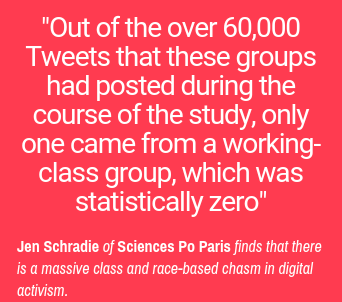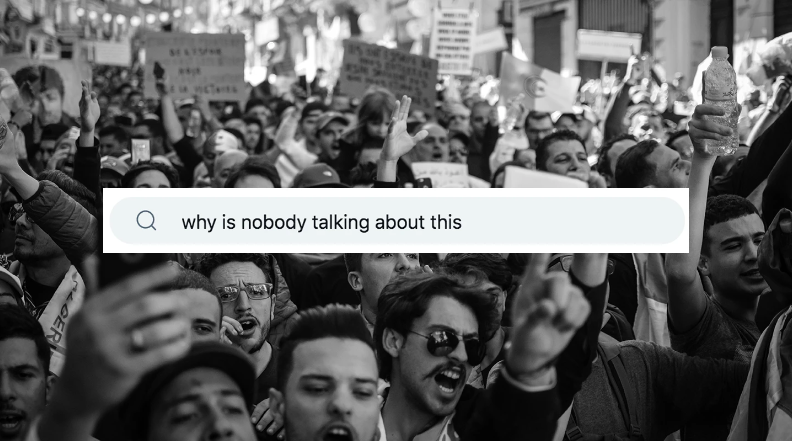I always wondered who decides which social movements deserve more global media attention and whether there is a digital inequality regarding this matter. Technology promises to free us from the arduous work required to build a social movement but even if poor and working-class people can overcome the costs and other barriers to internet access, fear, intimidation, and retaliation can limit their participation in comparison to their wealthy counterparts.
Schradie (2019) in her book “The Revolution That Wasn’t” asks the following questions: “Is digital activism as prevalent as we think? What kinds of groups use digital technology for activism? What are the factors that determine how a group uses these tools? What are the mechanisms behind differences in internet use for activism? Has digital activism truly created a level playing field where all groups and points of view can equally advocate for their cause?”
Posting on social media to raise awareness of a situation may involve minimal commitment, but it actually takes time, money and effort to engage in internet activism. As political groups shift online, the disparity in costs and power may aggravate inequalities within the social movements, making it more difficult for groups with lower resources and more working-class members to take collective action.
If we were to pinpoint what makes a social movement successful we could say that is when like-minded people come together to form a collective and engage in social issues by making clear purposes and objectives for their movement. A form of leadership is required, since, if the movement lacks representatives, people find it hard to identify or relate to its nature. Especially with self-proclaimed leaders and without a central decision-making structure, there is a high chance of failure to deliver a substantial change. Another important factor in the success of a movement is vigorous advocacy, people who publicly support your cause and spread the news about the movement. In the digital era, this could be easily achieved through the dissemination of your movement on social media platforms. You don’t have to have a strong connection to the traditional media to get your point through – you can generate the solidarity needed to undertake collective action by creating and maintaining an active and supportive internet audience. Nonetheless, there is the question of what happens when right-wing news and “movements” are at the forefront of digital activism and politics.

Middle and upper-class members have greater online access, time and skills to use social media accordingly, they could afford a better infrastructure and staffing resources to make their points come across as more effective and efficient. Lower-class participation online lacks the vertical organisation that is required and they face bureaucracy in their attempt to maintain their participation online. Hassanein (Granillo 2020) believes that “the ability to maintain a free, fair, accessible, neutral, virtual space, the ability to have high speed, affordable access for every resident of this country is contingent upon us demanding that our government regulate the internet as a utility […] our ability to use digital spaces for activating and organizing to change our physical environment is largely contingent upon those infrastructures being publicly owned.
A great example of this is the anti-vax movement that occurred in the 21st century after parents were reluctant to immunize their kids from measles or other diseases. According to disease experts, the parents who are least likely to vaccinate their children live in some of the country’s most affluent neighbourhoods, people who have excellent access to healthcare and are well-educated. While some low-income communities of colour are “under-vaccinated” for religious or financial reasons, studies published in the American Journal of Public Health show that the parents who choose not to vaccinate for “philosophical reasons” are mostly white and wealthy. They have more free time than lower-income parents, which they can spend reading anti-vaccine forums and websites and applying for state-specific exemptions required to avoid school immunisation laws. They also use Facebook and other platforms to spread their views and fake news, such as vaccines causing autism or containing harmful toxins, both of which have been thoroughly debunked.
So is social media helping movements turn towards more democratic participation? Can we overcome power imbalances? Schradie ( 2019 p.9) suggests that “this is the false promise of digital activism. Rather than creating a level playing field, where every- one’s voices are equal, the internet is creating a growing disparity that is giving an edge to some groups in surprising and unexpected ways. Digital activism may have some advantages, but not for everyone.”
References:
Granillo, G. (2020) The role of social media in Social Movements, Portland Monthly. Portland Monthly. Available at: https://www.pdxmonthly.com/news-and-city-life/2020/06/the-role-of-social-media-in-social-movements (Accessed: November 4, 2022).
Schradie, J. (2019) The revolution that wasn’t: How digital activism favors conservatives. Cambridge: Harvard University Press.


